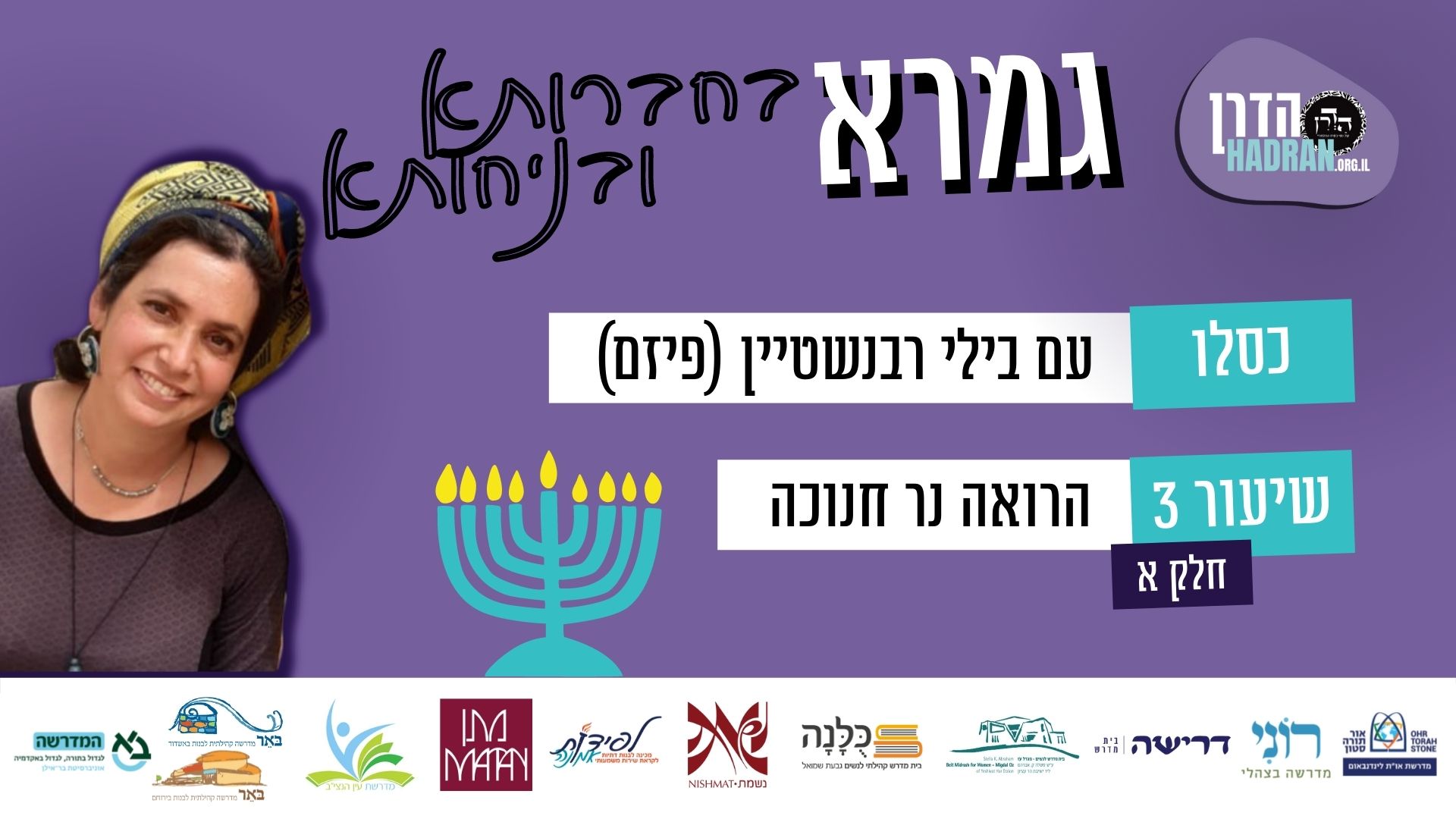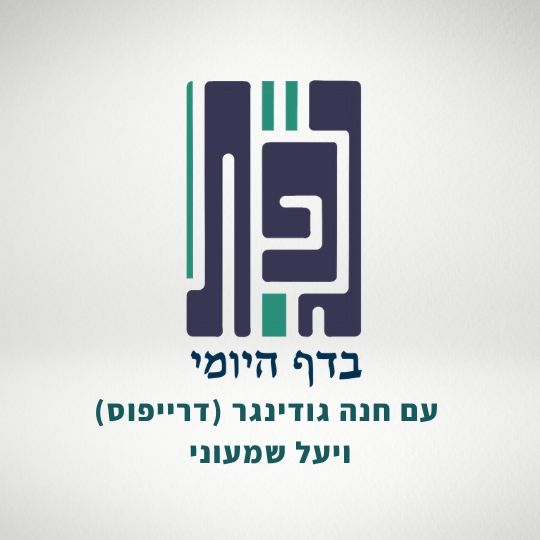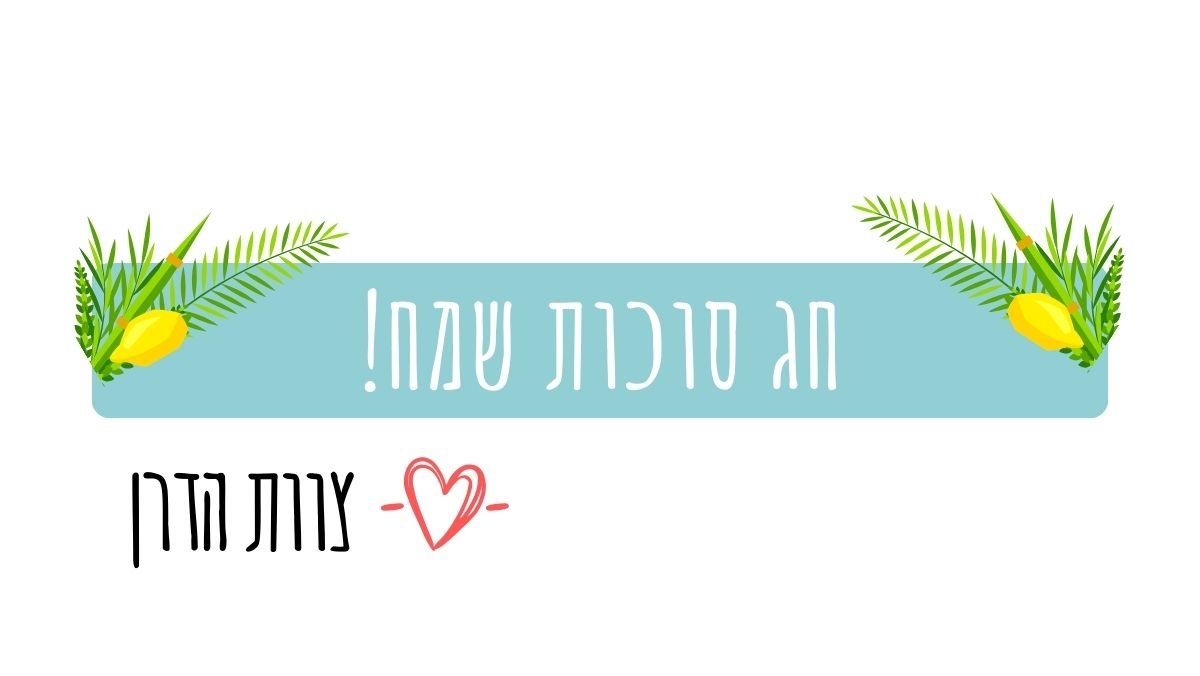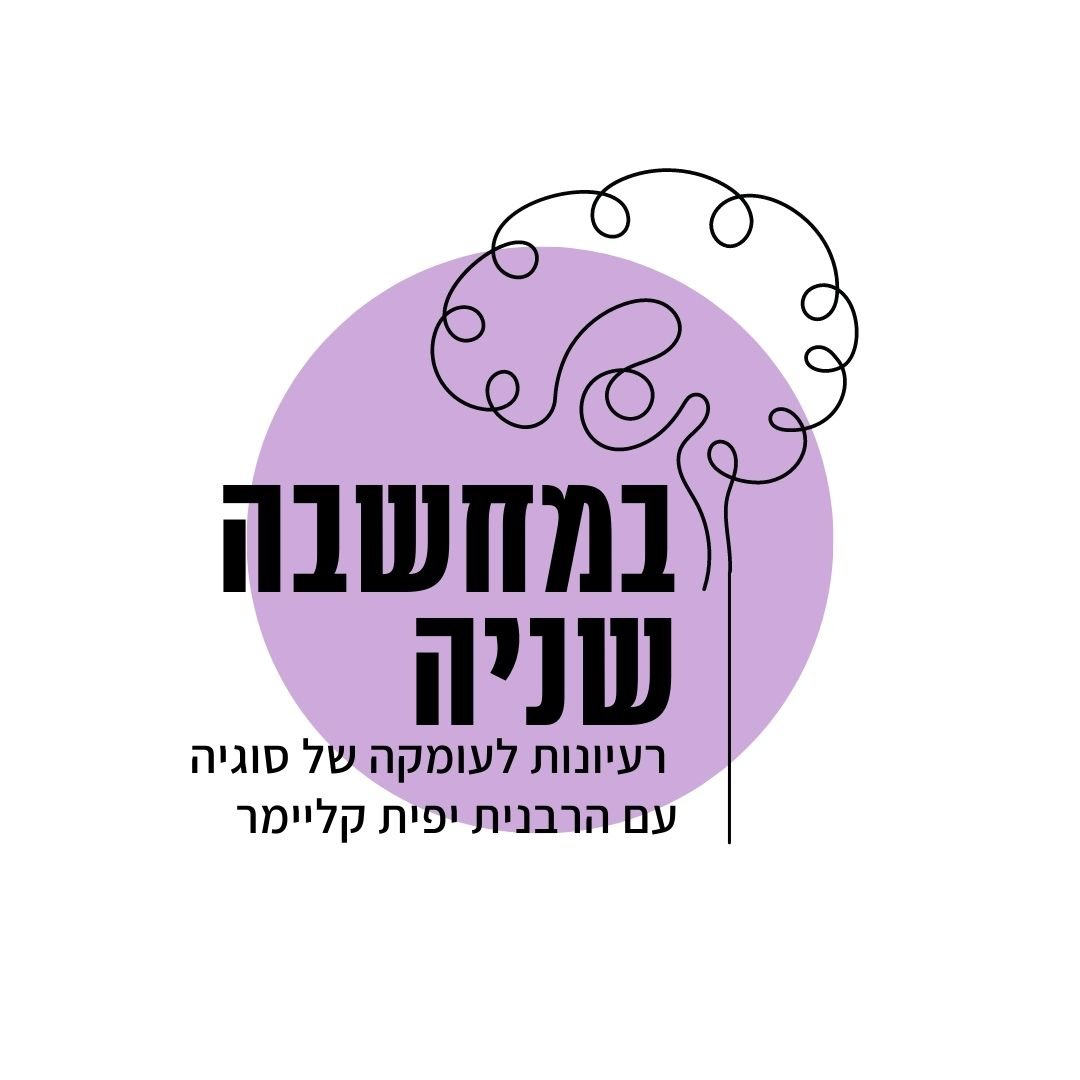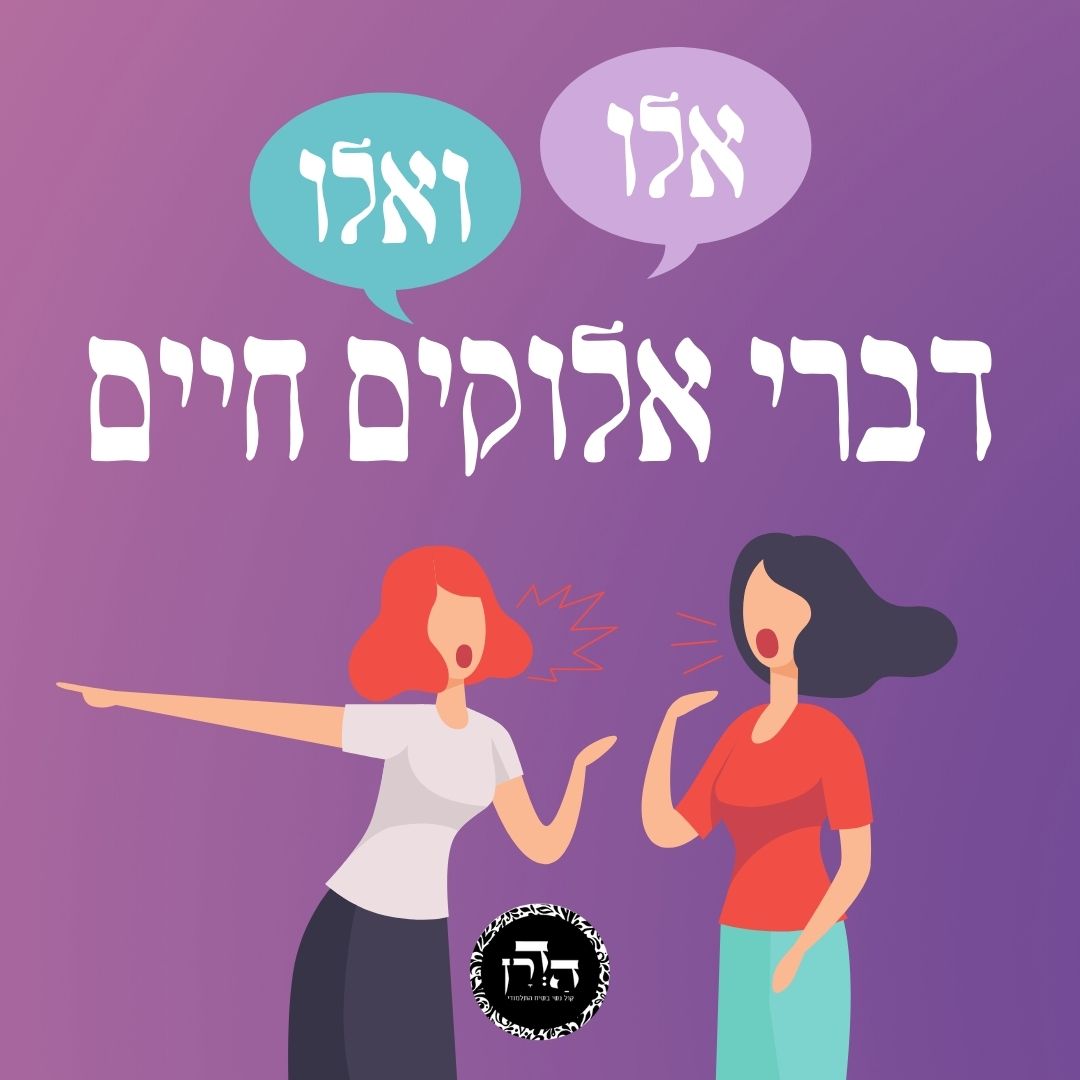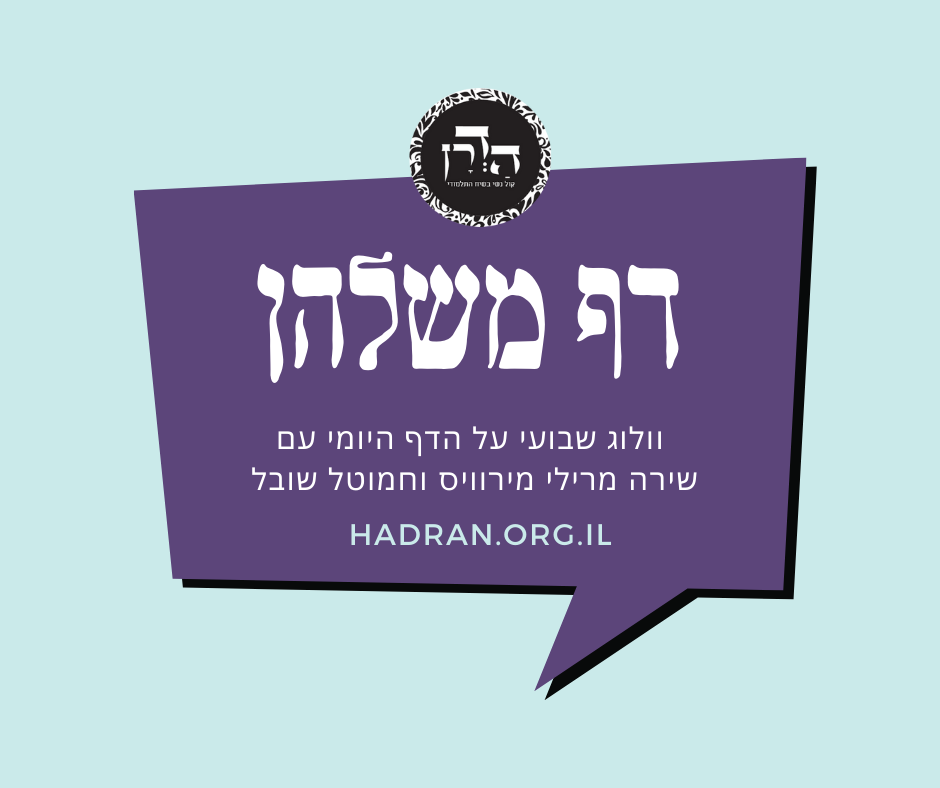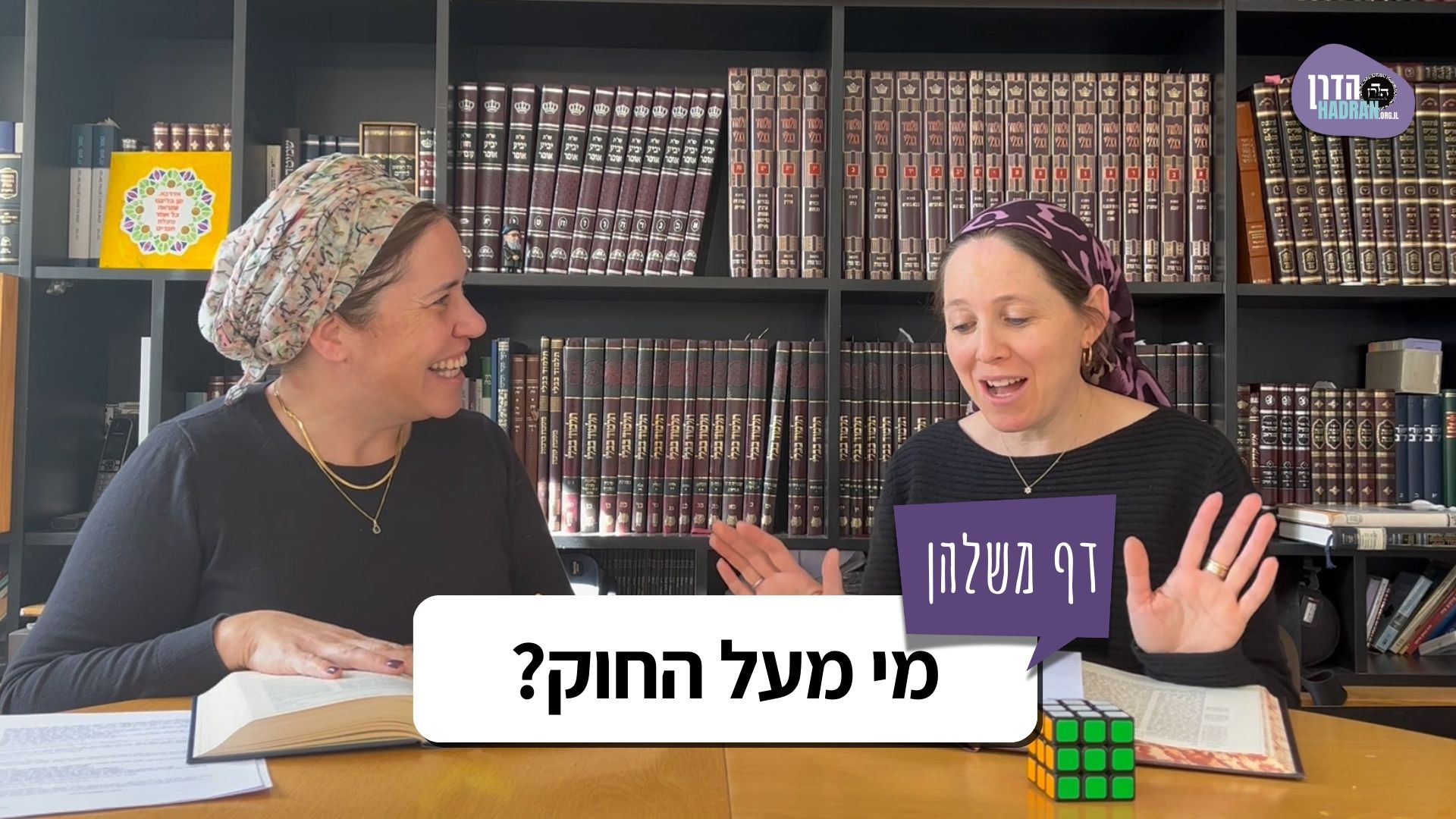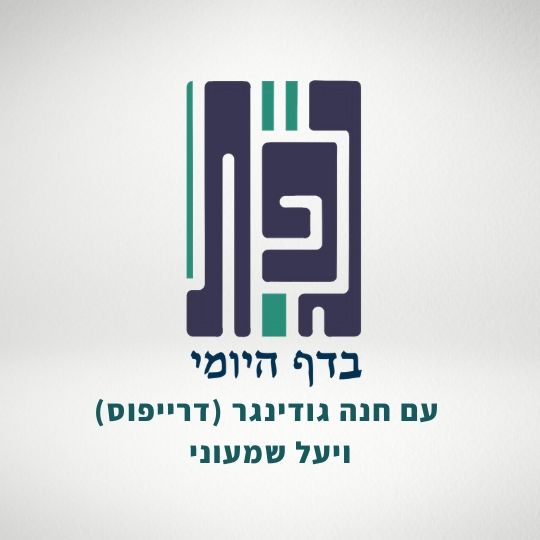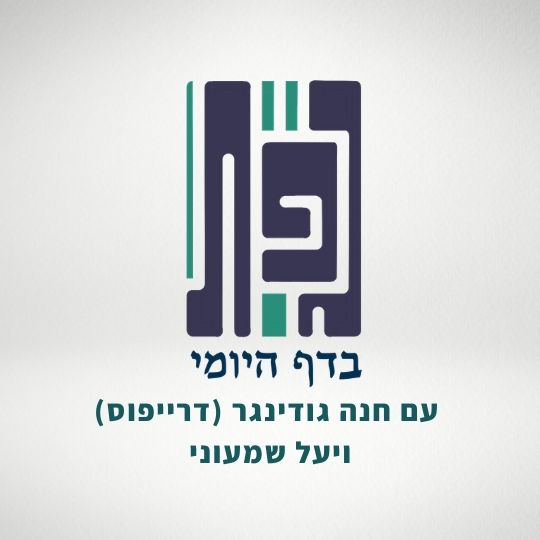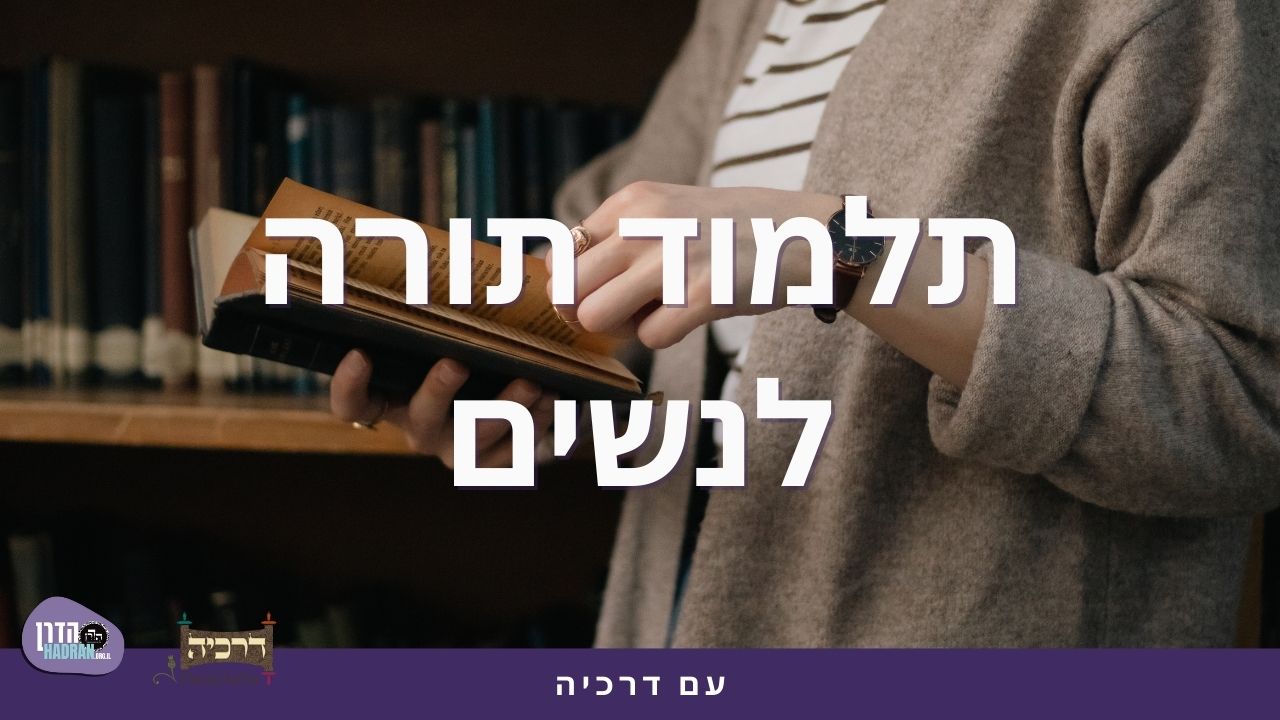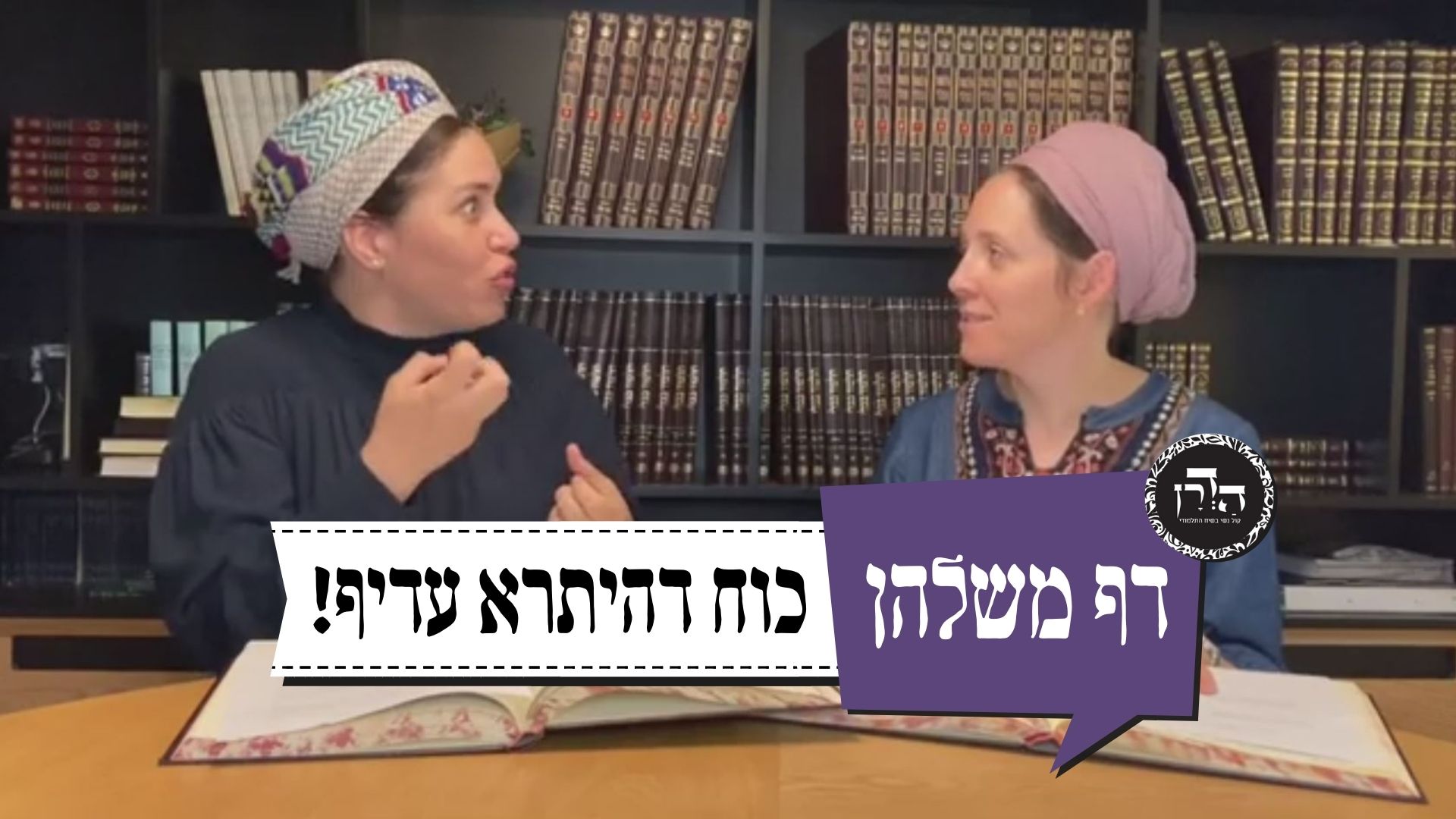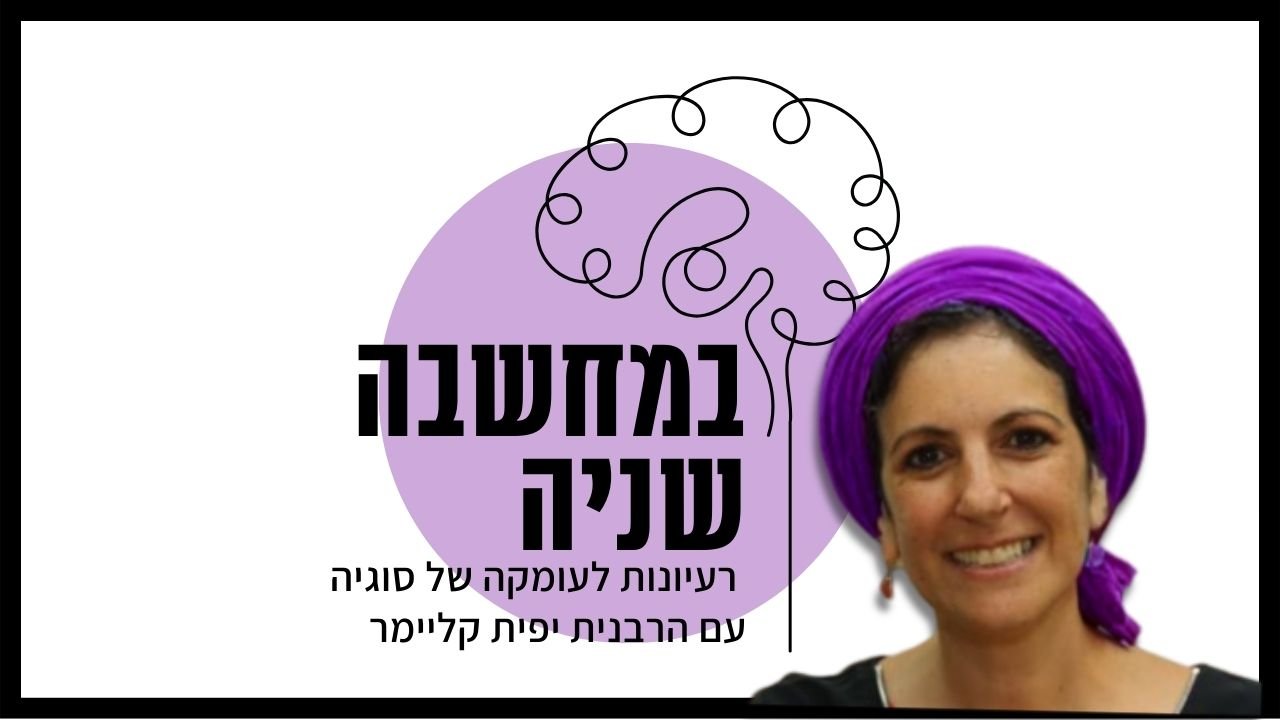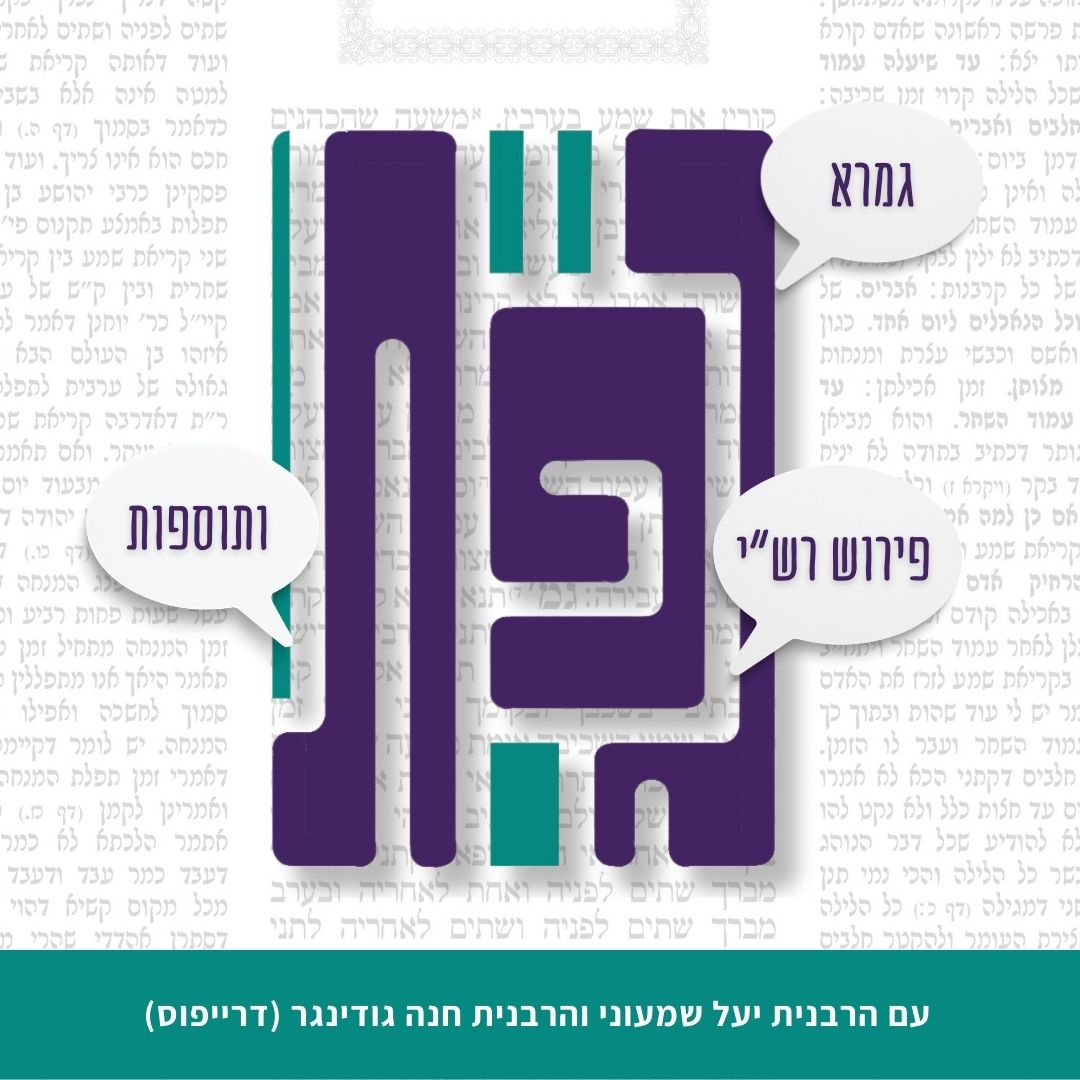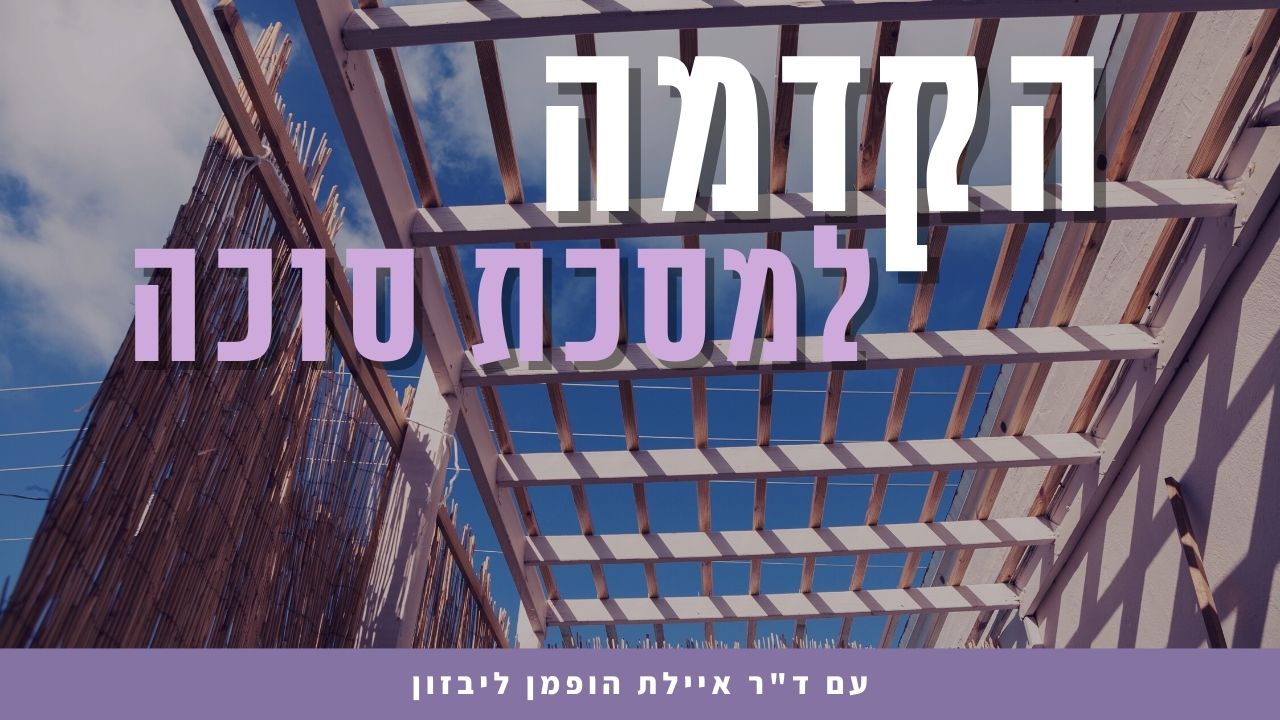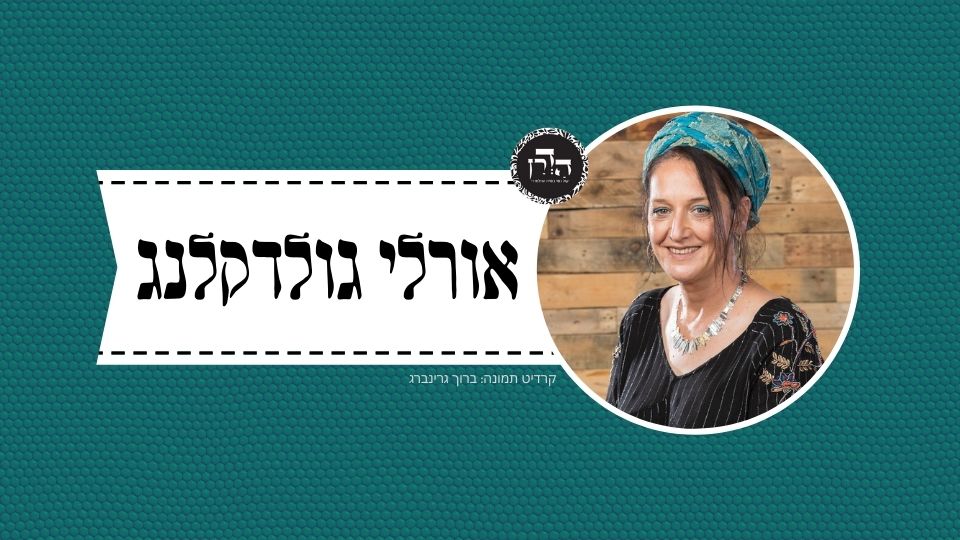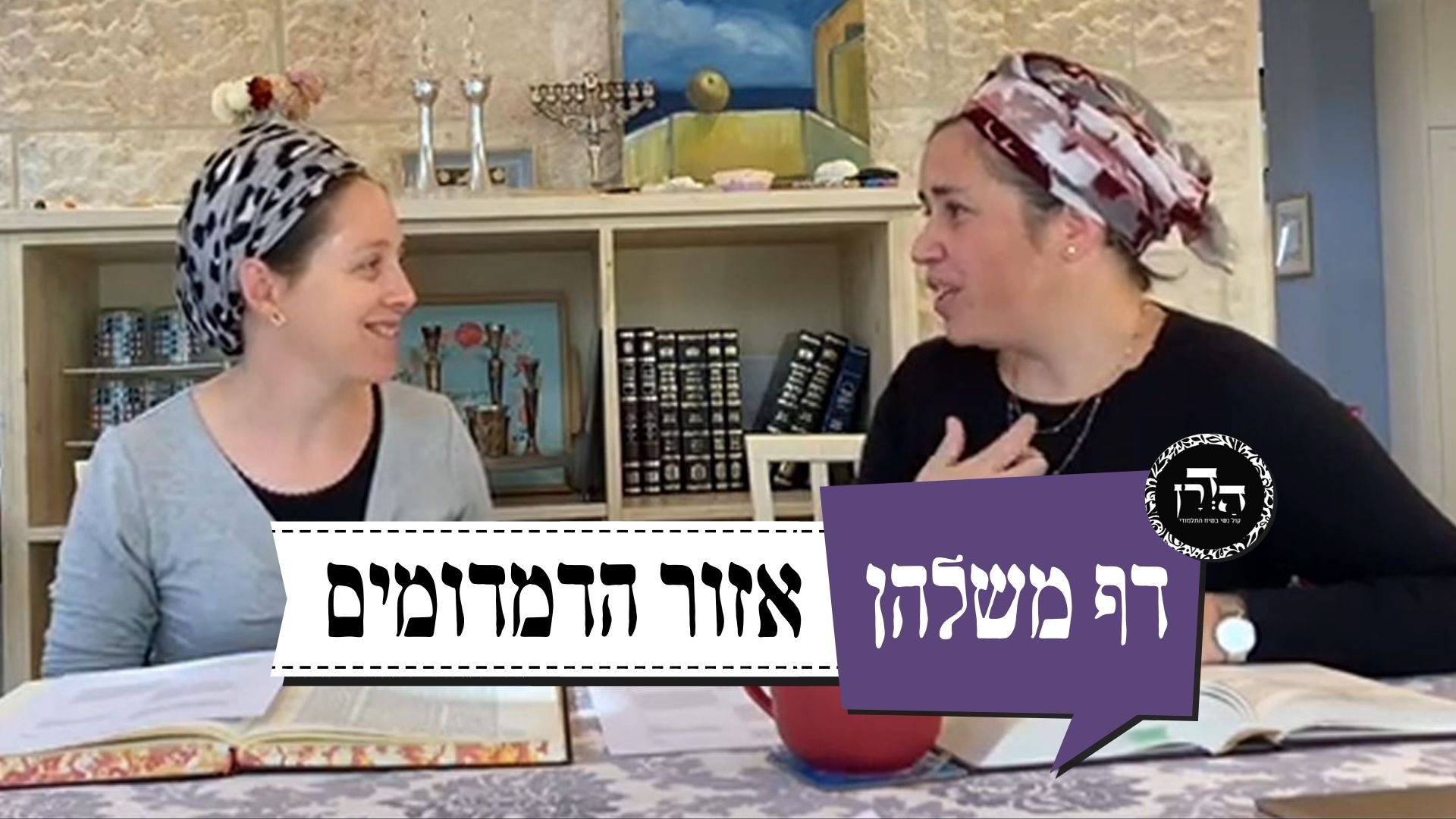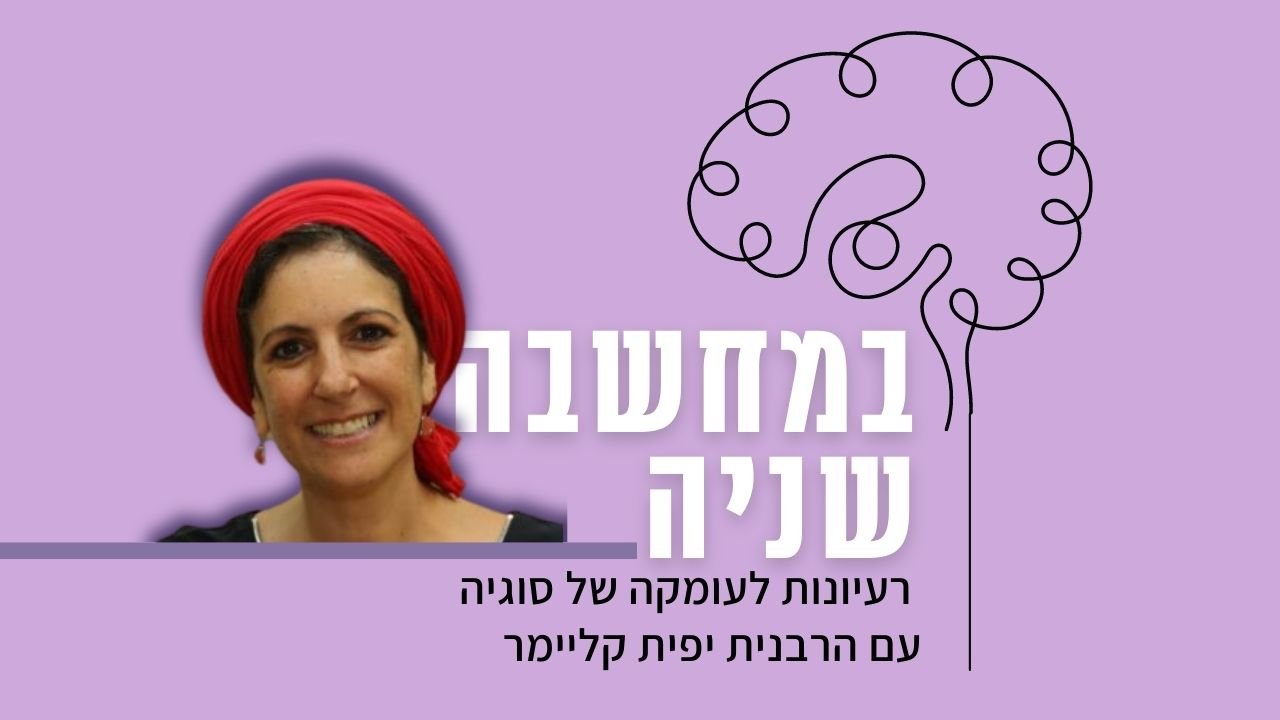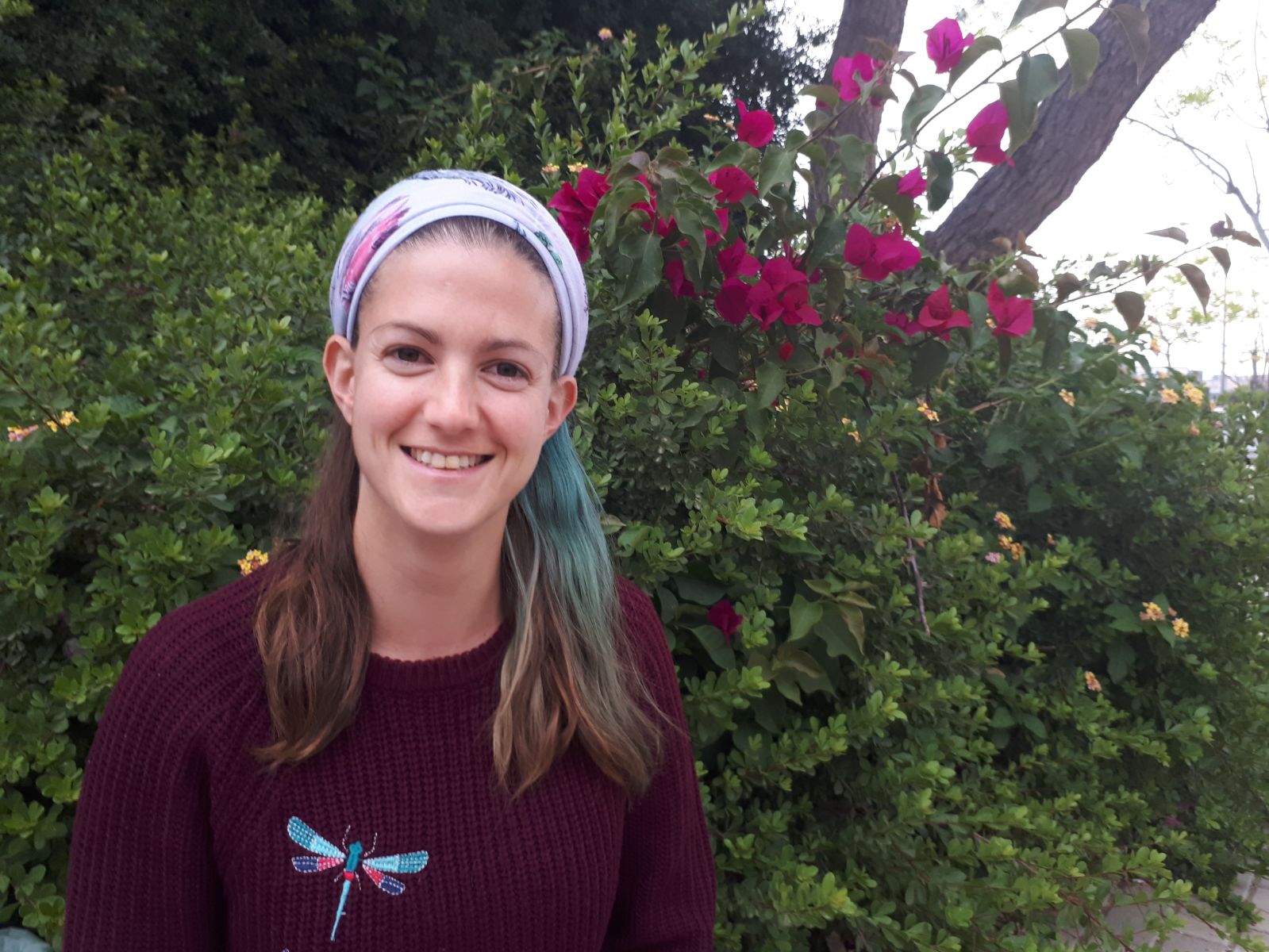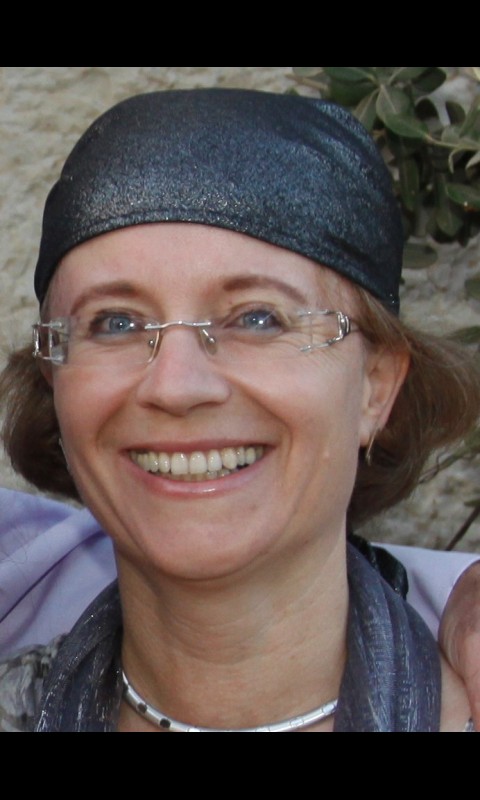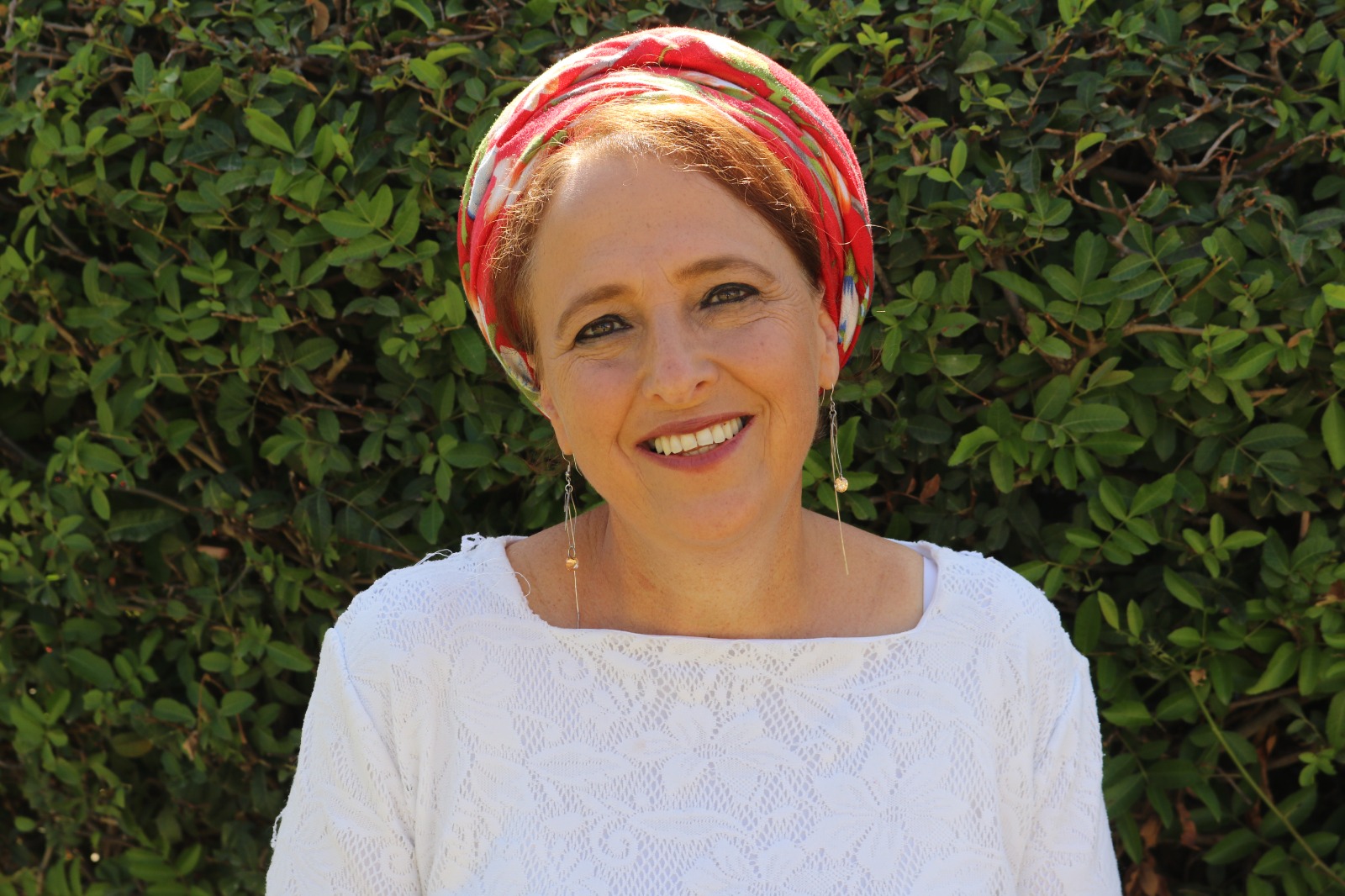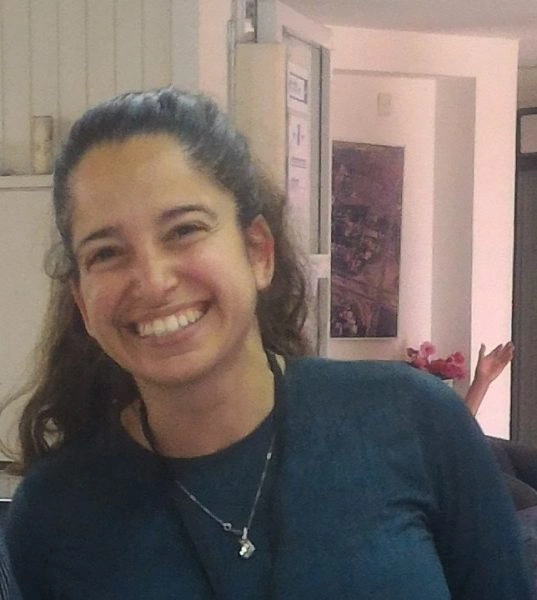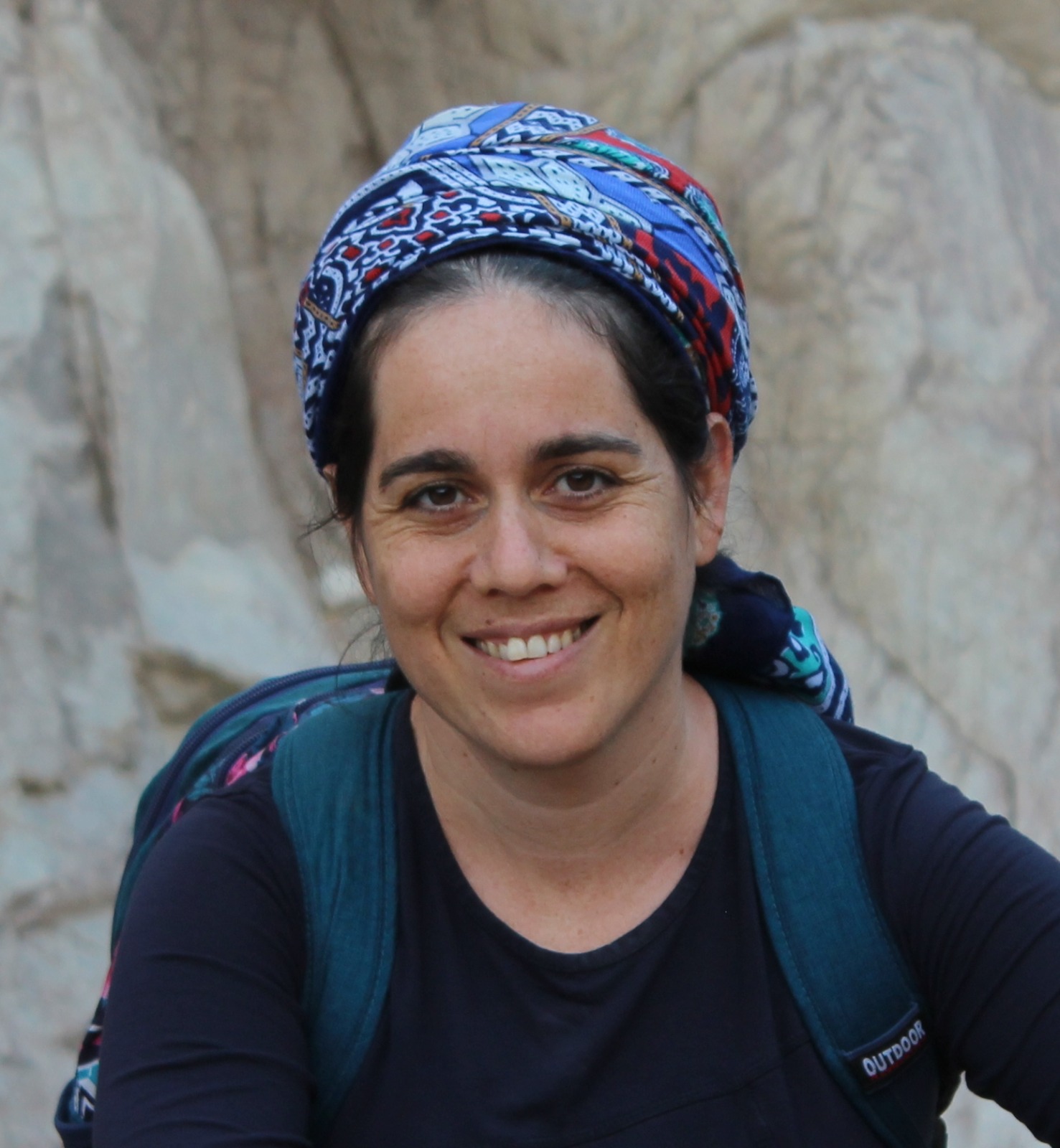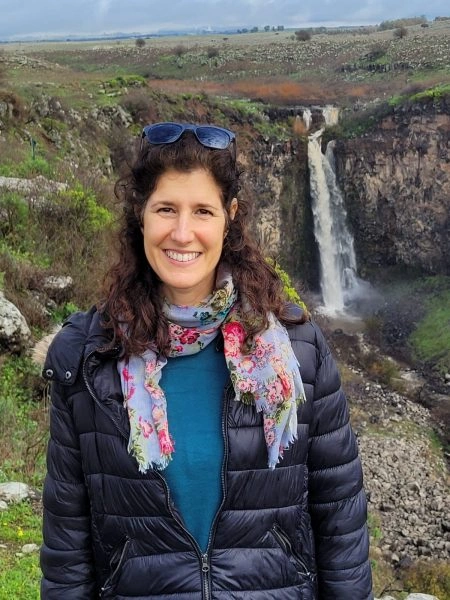האם משקים היוצאים מתרומה מפירות שאינם ענבים וזיתים (לאחר שהפרישו אותם כתרומה מהפרי עצמו) נשראת קדושת תרומה עליהם או לא? מהם כל הסוגים של דברים שרשומים במשנה שמצטרפים לטומאת אוכלים אבל לא מטמאים בעצמם וגם אין להם טומאת נבילה? הגמרא דנה בחלק השני של המשנה שמדברים על ההבדל בין טומאת אוכלים לטומאת נבילה בבהמה שנשחטה ועדיין מפרכסת (או שעכו”ם שחט או שיהודי שחט בבהמה טמאה).
הלימוד השבוע מוקדש ע”י רוברט ופאולה כהן לע”נ יוסף בן משה הכהן ז”ל. יוסף היה חזן שאהב מאוד לשיר, עבד קשה בחייו והיה מאוד מסור למשפחתו ולקהילה.
רוצה להקדיש שיעור?

כלים
הלימוד השבוע מוקדש ע”י רוברט ופאולה כהן לע”נ יוסף בן משה הכהן ז”ל. יוסף היה חזן שאהב מאוד לשיר, עבד קשה בחייו והיה מאוד מסור למשפחתו ולקהילה.
כלים
העמקה
רוצה להבין מה באמת קורה מתחת לפני השטח של הסוגיה?
שיעורים, פודקאסטים והרחבות של מיטב המורות שלנו יפתחו לך עוד זוויות וכיווני חשיבה.
חדשה בלימוד הגמרא?
זה הדף הראשון שלך? איזו התרגשות עצומה! יש לנו בדיוק את התכנים והכלים שיעזרו לך לעשות את הצעדים הראשונים ללמידה בקצב וברמה שלך, כך תוכלי להרגיש בנוח גם בתוך הסוגיות המורכבות ומאתגרות.
פסיפס הלומדות שלנו
גלי את קהילת הלומדות שלנו, מגוון נשים, רקעים וסיפורים. כולן חלק מתנועה ומסע מרגש ועוצמתי.
חולין קכא
והדר מייתי לה לערלה פרי פרי מבכורים:
And then he derives the halakha of liquid that emerges from orla from first fruits via a verbal analogy between one instance of the word fruit and another instance of the word fruit. With regard to orla the verse states: “And you shall count the fruit thereof as forbidden” (Leviticus 19:23), and with regard to first fruits the verse states: “And you shall take of the first of all the fruit of the ground” (Deuteronomy 26:2). Therefore, just as with regard to first fruits the status of liquid that emerges from the produce is like that of the produce only with regard to grapes and olives, so too with regard to orla one receives lashes only for drinking the liquid of grapes and olives, but not for drinking the liquid of other types of produce.
והאלל: מאי אלל רבי יוחנן אמר מרטקא ור”ל אמר בשר שפלטתו סכין
§The mishna teaches that the alal joins together with the flesh to constitute the requisite egg-bulk to impart the impurity of food, despite not being considered food itself. The Gemara asks: To what is the term alal referring? Rabbi Yoḥanan says: It is referring to the nuchal ligament [marteka]. And Reish Lakish says: It is referring to the meat residue that is attached to the hide after the knife has flayed the flesh.
מיתיבי (איוב יג, ד) ואולם אתם טופלי שקר רופאי אליל כולכם בשלמא למאן דאמר מרטקא היינו דלאו בר רפואה הוא אלא למאן דאמר בשר שפלטתו סכין בר רפואה הוא
The Gemara raises an objection to the explanation of Reish Lakish from that which is written: “But you are plasterers of lies, you are all physicians of no value [elil]” (Job 13:4). The term “no value [elil]” stems from the same linguistic root as the word alal. Granted, according to the one who says that the word alal is referring to the nuchal ligament, i.e., Rabbi Yoḥanan, that is why Job accused his companions of giving advice without merit by making an analogy to a physician who attempts to heal the nuchal ligament, which cannot be healed. But according to the one who says that the word alal is referring to the meat residue that is attached to the hide after the knife has flayed the flesh, i.e., Reish Lakish, flesh that is hanging from the hide is able to be healed.
באלל דקרא דכ”ע לא פליגי כי פליגי באלל דמתניתין
The Gemara answers: With regard to the term elil in the verse, everyone agrees that it is referring to the nuchal ligament. When Rabbi Yoḥanan and Reish Lakish disagree, it is with regard to the definition of the term alal employed by the Sages in the mishna.
ת”ש ר’ יהודה אומר האלל המכונס אם יש כזית במקום אחד חייבין עליו ואמר רב הונא והוא שכנסו
Come and hear a resolution from that which is taught in the mishna: Rabbi Yehuda says: With regard to the alal that was collected, if there is an olive-bulk of it in one place it imparts the impurity of animal carcasses. Therefore, one who eats it or touches it and then eats consecrated food or enters the Temple is liable to receive karet for it. And Rav Huna said: This halakha is applicable only when a halakhically competent person collected the alal in one place, but not if the alal was collected by a child or without human intervention. By collecting it in one place, the person indicates that he considers it to be food.
בשלמא למ”ד בשר שפלטתו סכין היינו דכי איכא כזית מיחייב אלא למ”ד מרטקא כי איכא כזית מאי הוי עץ בעלמא הוא
Granted, according to the one who says that the word alal is referring to the meat residue that is attached to the hide after the knife has flayed the flesh, i.e., Reish Lakish, that is why Rabbi Yehuda says that one is rendered liable when there is an olive-bulk of alal collected in one place, because the person who collected it considers it to be food. But according to the one who says that the word alal is referring to the nuchal ligament, i.e., Rabbi Yoḥanan, even in a case when there is an olive-bulk of alal collected in one place, what of it? It is merely wood, i.e., it is unfit for consumption.
אליבא דר’ יהודה לא פליגי כי פליגי אליבא דרבנן ר’ יוחנן אמר מרטקא נמי מצטרף וריש לקיש אמר דוקא בשר שפלטתו סכין אבל מרטקא לא מצטרף
The Gemara answers: According to the opinion of Rabbi Yehuda, Rabbi Yoḥanan and Reish Lakish do not disagree; they agree that the term alal is referring to the meat residue attached to the hide after the knife has flayed the flesh. When they disagree, it is with regard to the definition of the word alal according to the opinion of the Rabbis. Rabbi Yoḥanan says: The Rabbis maintain that the nuchal ligament also joins together with the meat to constitute the requisite measure of an egg-bulk to impart the impurity of food. And Reish Lakish says: The Rabbis maintain that specifically the meat residue that is attached to the hide after the knife has flayed the meat joins together with the flesh, but the nuchal ligament does not join together.
האי בשר שפלטתו סכין היכי דמי אי דחשיב עליה אפי’ באנפי נפשיה מיטמא ואי דלא חשיב עליה בטוליה בטליה
What are the circumstances of that which is taught in the mishna, that the meat residue that is attached to the hide after the knife flayed the flesh joins together with the meat to constitute the measure of an egg-bulk required to impart the impurity of food? If it is a case where one intends to eat this meat residue, then it can become impure not only by joining together with the meat, but even by itself, like any other food. And if it is a case where one does not intend to eat this meat residue, why should it be susceptible to impurity at all? One has completely nullified its status as food.
רבי אבין ורבי מיישא חד אמר מקצתו חישב עליו
Rabbi Avin and Rabbi Meyasha answered this dilemma. One said: It is a case where one intends to eat part of the meat residue, but it is uncertain which part. Therefore, the meat residue is not susceptible to impurity by itself because it is not entirely considered to be food, but the part that he intends to eat joins together with the meat to constitute the measure of an egg-bulk.
וחד אמר מקצתו פלטתו חיה ומקצתו פלטתו סכין
And one said: It is a case where one does not intend to eat any part of the meat residue. Rather, an animal severed part of the meat residue attached to the hide, and therefore that part of the meat residue retains its status as food. And the knife severed part of the meat residue, and one therefore nullified its status as food with regard to that part. Since it is uncertain which part was severed by a knife and which part by an animal, the meat residue itself is not susceptible to impurity, but the part that was severed by an animal joins together with the meat to constitute the measure of an egg-bulk.
תנן התם החרטום והצפרנים מיטמאין ומטמאין ומצטרפין חרטום עץ בעלמא הוא
§The mishna stated that the horns join together with the flesh to constitute the requisite egg-bulk to impart the impurity of food. The Gemara comments that we learned in a mishna elsewhere (Teharot 1:2): The beak and the talons of a bird that come into contact with a creeping animal can become impure, and transmit impurity to food, and join together with the attached flesh to constitute the requisite measure to impart impurity. The Gemara asks: Why does a beak join together with the flesh to impart impurity? It is merely wood, i.e., it is unfit for consumption.
אמר רבי אלעזר בחרטום תחתון תחתון נמי עץ בעלמא הוא אמר רב פפא תחתון של עליון
Rabbi Elazar says: The mishna is stated with regard to the lower half of the beak, i.e., the lower mandible. The Gemara objects: The lower mandible is also merely wood. Rav Pappa says: The mishna is discussing the lower section of the upper mandible and is referring to the membrane inside the mouth that is attached to the beak.
צפרנים אמר רבי אלעזר מקום המובלעים בבשר
Similarly, with regard to the talons mentioned in that mishna, Rabbi Elazar says: That mishna is not discussing the talons themselves, but rather the place at the base of the talon that is subsumed within the flesh.
קרנים אמר רב פפא במקום שחותכין ויוצא מהן דם:
Similarly, with regard to the horns mentioned in the mishna, Rav Pappa says: The mishna is not discussing the hard substance of the horn, but rather is referring to the place at the base of the horns where one severs the horns and blood flows from them.
כיוצא בו השוחט בהמה:
§The mishna teaches: Similarly, in the case of one who slaughters a non-kosher animal for a gentile and the animal is still twitching and comes into contact with a source of impurity, it imparts impurity of food, but does not impart impurity of an animal carcass.
אמר רבי אסי שונין ישראל בטמאה ועובד כוכבים בטהורה צריכין מחשבה והכשר מים ממקום אחר
Rabbi Asi says: Some Sages teach that when a Jew slaughters a non-kosher animal or a gentile slaughters a kosher animal, in order for it to be susceptible to impurity of food, it is necessary that the intention of the one performing the slaughter be that the flesh be designated as food while it is still twitching. And furthermore, in order for the animal to be rendered susceptible to impurity, it requires contact with water or another liquid that renders food susceptible to impurity that comes from another place. The blood of this slaughter is not considered a liquid that renders food susceptible to impurity because it flowed from a valid slaughter.
הכשר למה לי סופו לטמא טומאה חמורה וכל שסופו לטמא טומאה חמורה לא בעי הכשר
The Gemara asks: Why do I need the animal to come in contact with liquid in order for it to be rendered susceptible to impurity of food? The flesh of the animal will eventually become impure with a more severe level of impurity when it dies, i.e., impurity of an animal carcass. And any food that will eventually become impure with a more severe level of impurity does not require contact with liquid to be rendered susceptible to impurity of food.
דתני דבי רבי ישמעאל (ויקרא יא, לח) וכי יותן מים על זרע מה זרעים שאין סופן לטמא טומאה חמורה צריכין הכשר אף כל שאין סופו לטמא טומאה חמורה צריך הכשר
The Gemara now explains the source of this principle. As the school of Rabbi Yishmael teaches: With regard to rendering food susceptible to impurity through contact with liquid, the verse states: “But if water is put upon the seed, and any of the carcass falls on it, it is impure for you” (Leviticus 11:38). Just as seeds, which will never contract a more severe level of impurity, because no form of severe impurity applies to foods other than meat, require contact with liquid to render them susceptible to their less severe level of impurity, so too any food that will never contract a more severe level of impurity requires contact with liquid to be rendered susceptible to impurity of food. By contrast, any food that will become impure with a more severe level of impurity does not require contact with liquid to be rendered susceptible to impurity of food.
ותניא א”ר יוסי מפני מה אמרו נבלת עוף טהור צריכה מחשבה ואינה צריכה הכשר מפני
And similarly, it is taught in a baraita that Rabbi Yosei says: For what reason did the Sages say that in order for the carcass of a kosher bird to become susceptible to impurity it requires that the intention of the one performing the slaughter be to designate the animal as food, but it is not required for the bird to be rendered susceptible to impurity through contact with liquid? The reason is because
שסופה לטמא טומאה חמורה
eventually the carcass of the bird will impart a more severe impurity when it is in the throat of the person who consumes it. Therefore, it is not necessary for the carcass of a kosher bird to come in contact with liquid in order for it to be susceptible to impurity.
אמר חזקיה הואיל ויכול לגוררה ולהעמידה על פחות מכזית
Ḥizkiyya says in response: The reason for the opinion of the Sages stated by Rabbi Asi is since the slaughterer is able to chop the animal into small pieces and thereby establish the volume of every piece of the animal as less than an olive-bulk. In such a scenario, the animal would not be susceptible to impurity. Therefore, it is not certain that the animal will eventually become impure with a more severe impurity.
א”ל ר’ ירמיה לרבי זירא ומי אמר חזקיה הכי והא איתמר שחט בה שנים או רוב שנים ועדיין היא מפרכסת חזקיה אמר אינה לאברים ר’ יוחנן אמר ישנה לאברים
Rabbi Yirmeya said to Rabbi Zeira: And did Ḥizkiyya actually say such a statement? But wasn’t it stated: If one slaughtered a non-kosher animal in a valid manner by cutting the two simanim, i.e., the windpipe and the gullet, or the majority of the two simanim, and the animal is still twitching, Ḥizkiyya says: There is no prohibition against eating the limbs from such a twitching animal. Therefore, a gentile, who is prohibited from consuming a limb from a living animal, may consume this animal. Rabbi Yoḥanan says: There is a prohibition against eating the limbs of such an animal.
חזקיה אמר אינה לאברים מתה היא רבי יוחנן אמר ישנה לאברים לאו מתה היא
The Gemara explains the opinions: Ḥizkiyya says that there is no prohibition against eating the limbs of such an animal, as since it was slaughtered in a valid manner it is considered dead. Rabbi Yoḥanan says that there is a prohibition against eating the limbs of such an animal, as since it is twitching it is not yet dead. Therefore, since Ḥizkiyya maintains that a twitching animal is considered dead, it should have the impurity of a carcass, contrary to the opinion of the Sages cited by Rabbi Asi, as well as the mishna.
א”ל יצתה מכלל חיה ולכלל מתה לא באת
Rabbi Zeira said to Rabbi Yirmeya in response: Ḥizkiyya maintains that such an animal has left the category of a living animal, but has not entered the category of a dead animal. Therefore, it is not prohibited for a gentile to consume such an animal, but the animal does not have the impurity of a carcass.
גופא שחט בה שנים או רוב שנים ועדיין היא מפרכסת חזקיה אמר אינה לאברים ר’ יוחנן אמר ישנה לאברים אמר ר’ אלעזר נקוט להא דר’ יוחנן בידך דתני רב אושעיא כוותיה
§The Gemara discusses the matter itself of the dispute between Ḥizkiyya and Rabbi Yoḥanan: If one slaughtered a non-kosher animal by cutting the two simanim, or the majority of the two simanim, and the animal is still twitching, Ḥizkiyya says: There is no prohibition against eating its limbs. Rabbi Yoḥanan says: There is a prohibition against eating its limbs. Rabbi Elazar said: Take that opinion of Rabbi Yoḥanan in your hand and accept it, as Rav Oshaya teaches a baraita in accordance with his opinion.
דתני רב אושעיא ישראל ששחט בהמה טמאה לעובד כוכבים שחט בה שנים או רוב שנים ומפרכסת מטמאה טומאת אוכלין אבל לא טומאת נבלות
As Rav Oshaya teaches (Tosefta, Oholot 2:1): In the case of a Jew who slaughtered a non-kosher animal for the consumption of a gentile, if he slaughtered it by cutting two simanim or the majority of two simanim, and the animal is still twitching, the animal imparts impurity of food; but so long as it is twitching it does not impart the impurity of animal carcasses.
אבר הפורש ממנה כפורש מן החי ובשר הפורש ממנה כבשר הפורש מן החי ואסור לבני נח ואפי’ לאחר שתצא נפשה
A limb that separates from this twitching animal is considered like a limb that separates from a living animal, and as such it imparts the impurity of a carcass. And flesh that separates from this twitching animal is considered like flesh that separates from a living animal, and as such it does not impart impurity. And it is prohibited for the descendants of Noah to consume the flesh that separates from this twitching animal, and this prohibition applies even after its soul departs. This ruling of Rav Oshaya is in accordance with the opinion of Rabbi Yoḥanan.
שחט בה אחד או רוב אחד אינה מטמאה טומאת אוכלין נחרה אין בה טומאה של כלום
The Gemara cites the continuation of the Tosefta: In the case where a Jew slaughtered a non-kosher animal for a gentile’s consumption, if he slaughtered it by cutting only one siman or the majority of one siman, and the animal is still twitching, the animal does not impart the impurity of food because the slaughter was invalid. Similarly, if he did not perform a valid slaughter but rather stabbed the animal, the animal has no impurity whatsoever while it is still twitching.
ועובד כוכבים ששחט בהמה טהורה לישראל ומפרכסת מטמאה טומאת אוכלין אבל לא טומאת נבלה
And similarly, in the case of a gentile who slaughtered a kosher animal for the consumption of a Jew, and the animal is still twitching, the animal imparts the impurity of food because it is considered to be food, but so long as it is twitching it does not impart the impurity of an animal carcass.
אבר הפורש ממנה כפורש מן החי ובשר הפורש ממנה כפורש מן החי ואסור לבני נח ואפילו לאחר שתצא נפשה
A limb that separates from this twitching animal is considered like a limb that separates from a living animal, and as such it imparts the impurity of a carcass. And flesh that separates from this twitching animal is considered like flesh that separates from a living animal, and as such it does not impart the impurity of food. And it is prohibited for the descendants of Noah to consume the flesh that separates from this twitching animal, and this prohibition applies even after its soul departs.
שחט בה אחד או רוב אחד אינה מטמאה טומאת אוכלין נחרה אין בה טומאה של כלום
If the gentile slaughtered the kosher animal by cutting only one siman or the majority of one siman, and the animal is still twitching, the animal does not impart impurity of food because the slaughter was not valid. Similarly, if he stabbed the animal rather than slaughtering it properly, it has no impurity whatsoever.
שחט עובד כוכבים במקום שאין עושה אותה טרפה ובא ישראל וגמרה כשרה
If a gentile partially slaughtered a kosher animal in a place that does not render the animal a tereifa, i.e., unfit for consumption due to a mortal wound, e.g., he cut half of the windpipe, and then a Jew came and completed the slaughter, the animal is fit for consumption.
שחט ישראל בין במקום שעושה אותה טרפה ובין במקום שאין עושה אותה טרפה ובא עובד כוכבים וגמר שחיטתו פסולה
But if a Jew slaughtered the animal, either in a place that renders the animal a tereifa, e.g., he cut the majority of the windpipe, or in a place that does not render the animal a tereifa, e.g., he only partially cut the windpipe, and then a gentile came and completed the slaughter, his slaughter is not valid.
הרוצה שיאכל מבהמה קודם שתצא נפשה חותך כזית בשר מבית שחיטתה ומולחו יפה יפה ומדיחו יפה יפה וממתין לה עד שתצא נפשה ואוכלו אחד עובד כוכבים ואחד ישראל מותרין בו
The baraita continues: One who wishes to eat from the meat of a slaughtered animal before its soul departs may cut an olive-bulk of meat from the area of its slaughter, the neck, and salt it very well, i.e., more than is normally required, and rinse it very well in water to remove the salt and blood, and then wait until the animal’s soul departs, and then eat it. Both a gentile and a Jew are permitted to eat it because the prohibition against eating a limb from a living animal is not applicable in such a case.
מסייע ליה לרב אידי בר אבין דאמר רב אידי בר אבין א”ר יצחק בר אשיין הרוצה שיבריא חותך כזית בשר מבית שחיטה ומולחו יפה יפה ומדיחו יפה יפה וממתין לה עד שתצא נפשה אחד עובד כוכבים ואחד ישראל מותרים בו
The Gemara notes: This baraita supports the opinion of Rav Idi bar Avin, as Rav Idi bar Avin said that Rav Yitzḥak bar Ashyan said: One who wants to be healthy should cut an olive-bulk of meat from the area of the slaughter, and salt it very well and rinse it very well, and then wait until the animal’s soul departs, and then both a gentile and a Jew are permitted to eat it.
בעי ר’ אלעזר שהה בה דרס בה מהו
§It was previously taught in the baraita that if a Jew slaughtered a non-kosher animal for a gentile’s consumption, or a gentile slaughtered a kosher animal for a Jew’s consumption, that animal imparts impurity of food when it is twitching after the slaughter. With regard to that halakha, Rabbi Elazar raises a dilemma: What is the halakha in such a case if one interrupted the slaughter or pressed on the knife during the slaughter? Do these acts, which normally invalidate slaughter, also invalidate this slaughter, or does the slaughter in this case not have to fulfill all of the halakhic requirements of valid slaughter in order to render the slaughtered animal as food with regard to imparting the impurity of food?
א”ל ההוא סבא הכי א”ר יוחנן צריכה הכשר שחיטה כבהמה טהורה הכשר למאי אמר רב שמואל בר יצחק בדיקת סכין
A certain elder resolved this dilemma and said to him: Rabbi Yoḥanan said as follows: This case requires a valid slaughter in every detail, just like a Jew slaughtering a kosher animal. The Gemara clarifies: To what requirement does valid slaughter just like a kosher animal refer? Rav Shmuel bar Yitzḥak said: It is referring to the requirement of examining the knife before the slaughter.
בעא מיניה רבי זירא מרב ששת מהו שתציל על הבלועין שבתוכה
Rabbi Zeira asked Rav Sheshet: If a non-kosher animal slaughtered by a Jew is twitching under the same roof as a corpse, and the animal swallowed items before being slaughtered, what is the halakha with regard to those swallowed items that are inside the animal? Is the animal considered to be living and therefore it should save these items that are swallowed inside it from the impurity transmitted by the corpse to all items under the same roof? Or is the animal considered to be dead and therefore the items become impure?
א”ל מטמאה טומאת אוכלין ומצלת א”ל אינה מטמאה טומאת נבלות ולא תציל
Rav Sheshet said to Rabbi Zeira: Since it is established that such an animal is considered to be dead and imparts impurity of food, is it possible that it saves those items inside it from impurity? Certainly it does not. Rabbi Zeira said to him in response: It is also established that such an animal does not impart impurity of carcasses and is considered to be a living animal in that regard. How is it possible that the animal does not save those items inside it from impurity?
אמר אביי אינה מצלת על הבלועים שבתוכה דהא מטמאה טומאת אוכלין והרובעה חייב דהא אינה מטמאה טומאת נבלה:
Abaye resolved the dilemma and said: It is proper to treat this case stringently. Therefore, such an animal does not save the items that are swallowed inside it because it imparts impurity of food. But one who engages in bestiality with such an animal is liable because the animal does not impart impurity of a carcass and is considered to be living in that regard.
רבי יהודה אומר האלל [וכו’]: אמר רב הונא והוא שכנסו
§The mishna teaches that Rabbi Yehuda says: With regard to the meat residue attached to the hide after flaying that was collected, if there is an olive-bulk of it in one place it imparts impurity of an animal carcass, and one who contracts impurity from it and eats consecrated foods or enters the Temple is liable to receive karet for it. Rav Huna says in explanation: This halakha is applicable only when a halakhically competent person collected the meat residue in one place, but not if the meat residue was collected by a child or without human intervention. By collecting it in one place, the person indicates that he considers it to be food.
ואמר רב הונא שני חצאי זיתים שישנן על גבי העור העור מבטלן
And Rav Huna says: In a case of two pieces of flesh of an animal carcass, each measuring half an olive-bulk, that are attached to the hide, the hide nullifies them, as the hide does not impart the impurity of a carcass. Consequently, these pieces do not impart impurity either.
